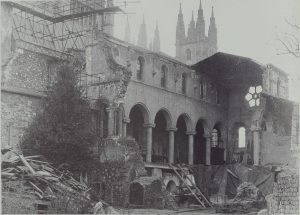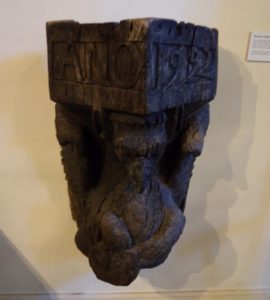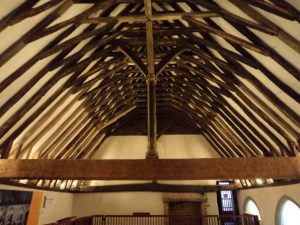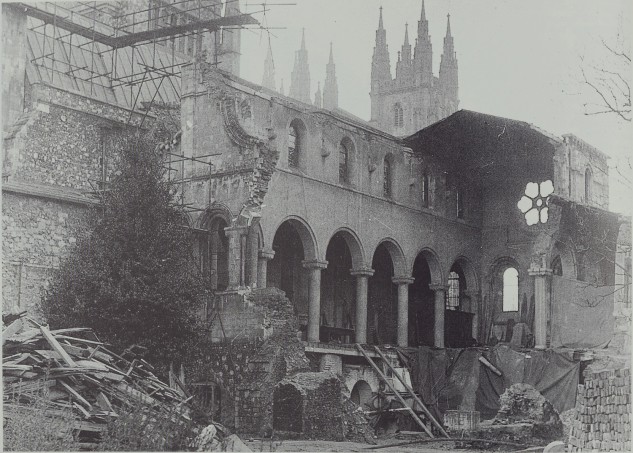It is often said, that in terms of Canterbury’s historic built environment the City Council in the post WWII years was far more effective in finishing off what the Luftwaffe had started during the Baedeker raids on the city in 1942. In some respects this story continues, and with regard to development and redevelopment both inside and outside the city wall the pace of such activities is and will in the next decade gather increasing momentum.

Taking examples from inside the city wall, one that will please many is the redevelopment in St Margaret’s Street of Slatters Hotel, which is long overdue. Ex-garage sites are similarly seen as targets for redevelopment to help to alleviate the housing problem, and sometimes this can be achieved in association with adjoining car parks. Among the former garage sites that are being redeveloped is 16 St Radigund’s Street, although in this case it is in the early stages of becoming the King’s School’s new day pupil house (Mitchinson’s) to replace the current house on the left inside the Mint Yard Gate. Nearby is another former garage site, then the temporary city library and presently The Marlowe Lab or youth theatre, which, I presume, will soon fit the more general trend of redevelopment for residential purposes.
Such changes to the city’s landscape, of course, have consequences for the immediate environment, but also knock-on repercussions for other locations and institutions across Canterbury in the immediate aftermath and often long into the future. Frequently these changes are labelled as progress, just as presumably the demolition of another City Council property, The Lion or The Red Lion, was envisaged in 1806 to create Guildhall Street. This great medieval inn had stood with its great yard behind next to the Guildhall (a combined WWII and post WWII casualty) since at least the early 15th century but the City Council’s desire to carve a much easier coach route to the High Street from Palace Street (and Thanet) sounded its death knell. However, you might say in this case, at least, the development was good for the properties in Sun Street (and Mercery Lane), although at the Sun Street end of Guildhall Street an number of property holders had to seek compensation at a judicial enquiry. Among those compensated were William Harnett who lost his drying room and an oil house (£110); the trustees of the Congregational chapel for the loss of part of their premises (£364 6s.); John Keeler for the loss of his dwelling (£90); James White who lost his washhouse and part of his yard (£205); William and George Keen whose tenement next to John Keeler’s was also demolished (£850), and Copper Chapman for the loss of part of his yard (£10 10s.).

Griffin (1592) thought to come from Elizabethan Canterbury, Canterbury Heritage Museum
Not very far away and on the other side of the High Street between the start of Jewry Lane and the present Abode Hotel was another great medieval inn that met a similar fate, but for different reasons. The Fleur de Lys was yet another casualty of the post WWII redevelopment, The Kent Messenger reporting in 1956 that the archaeological excavation in the hotel yard had revealed a two-foot thick Roman wall and tessellated pavement, while the inn itself had boasted a 13th-century window, Tudor staircase and fine ceiling before is demolition.
Preserving more than an increasingly vague memory of Canterbury’s historic landscape is an extremely important part of understanding and cherishing the city’s history and heritage for future generations. In addition to a Canterbury Museum that sets the city’s 20th-century history into a longer context of its whole past, this can be done through the collection, conservation and preservation of early amateur films made by local enthusiasts. A project, led by Tim Jones, Senior Lecturer in the School of Media, Art and Design at Canterbury Christ Church, is doing just that and he has now launched a website and blog at: https://blogs.canterbury.ac.uk/cafa/ . As some of you may know, he also has regular screenings of such films that are always well attended, the next is on Saturday 11 March, and together these form an amazing resource for scholars, but equally for those who have a more general interest, or who have their own memories of Canterbury’s topography during the 20th century.

Great Hall, looking towards the high end, Poor Priests’ Hospital
For whose with such memories, especially of the Second World War and even more the devastating raids of 1942, a half-day conference that the Centre is holding on Saturday 3 June will be particularly pertinent. Indeed, I expect this conference entitled ‘The Baedeker Raid on Canterbury – 75 years on’ will be of interest far more widely and we have had to cap the associated afternoon walk, led by Paul Bennett, Director of the Canterbury Archaeological Trust and Visiting Professor at the Centre, at 25 people. However, there is plenty of room in the Michael Berry Lecture Theatre in Old Sessions House and it would be excellent if we could encourage a large audience to come to the fascinating programme Dr Martin Watts has organised. Following refreshments, Martin will give a brief introduction, and then Professor Kevin Ruane (CCCU) will deliver a talk describing the background and context of the raid. After a second refreshment break during which people can again look at the photographic exhibition in the foyer of Old Sessions of the aftermath of the raid, provided by Canterbury Cathedral Archives and Library from its collections, Jordan Newton will speak. Jordan is a third year undergraduate at CCCU who will talk about the raid itself. The final talk will be delivered by Paul Bennett, an expert on Canterbury’s archaeology and history, as many of you will know on, and Tim Jones’s 10-minute film presentation will conclude the half-day conference. If this sounds interesting, please have a look on the Centre’s webpages at: http://www.canterbury.ac.uk/baedeker for more details and how to book.
Keeping with the theme of the changing landscape, it is worth drawing attention very briefly both to a paper I attended yesterday and several of the talks at the Tudors and Stuarts History Weekend, now less than a month away. There is still time to book and the online address for details is: http://www.canterbury.ac.uk/tudors-stuarts or email artsandculture@canterbury.ac.uk or phone 01227 782994. Thinking about the Weekend, Professor Kenneth Fincham, and Drs David Starkey, David Grummitt and Janina Ramirez will give talks that foreground the most notable changes in the landscape. Of these, three concern changes resulting from the early stages of the Reformation and the political repercussions that followed, whereas Professor Fincham will take us into the Stuart period and that fascinating archbishop, Archbishop Laud. Professor Fincham is a well-known expert on the Anglican Church under the Stuarts, and Laud, as the last archbishop to suffer execution, might still be said to divide opinion. However, during his time he polarised attitudes, attracting mistrust and hatred from across the British Isles. Such a personality with his ideas of the ‘beauty of holiness’ is eminently suitable for Canterbury, the heart of Anglicanism. In his talk Professor Fincham will explore the complex relations between religion and politics during Charles I’s reign, as well as why Laud provoked a backlash that saw the destruction of the Church and State that he held so dear.

Abbot – stone carvings rescued from St Augustine’s Abbey, Canterbury Heritage Museum
Finally, turning to Dr David Green’s paper on ‘The Tomb of Edward the Black Prince: Contexts, Incongruities and Questions’, it is noteworthy that he provided some interesting ideas about the tomb and the achievements as they now survive. The shield, cap of maintenance and other accoutrements have been the subject of recent study, as well as display at the V&A, and they will become part of a new display at Canterbury as part of the commemoration activities to mark Prince Edward’s death in 1377 – see the November conference to be held at Canterbury Cathedral. Moreover, scholars are fortunate that the terms of his chantries in the crypt chapels of the cathedral are known, and among other surviving documents is his will. I was struck, in particular, by the instructions given for his funeral procession, especially the provision of mounted knights with banners either denoting his martial pursuits – war, and those denoting peace. Of course, the cortege would have passed through the earlier Westgate before its rebuilding under the direction of Archbishop Sudbury, whose own tomb may, like that of Prince Edward, not be in the place where he had intended. However, for late 14th-century priors and their successors in their thinking about the cathedral’s internal ‘landscape’ both funeral monuments were presumably far more ‘useful’ beside the ‘pilgrim route’ and close to St Thomas’ shrine. Thus, as I mentioned a few weeks ago, ideas about historic landscapes and concepts such as place and space offer exciting opportunities to investigate society – in the past, today and for the future.
 Centre for Kent History and Heritage
Centre for Kent History and Heritage Sheila Sweetinburgh
Sheila Sweetinburgh 1109
1109


